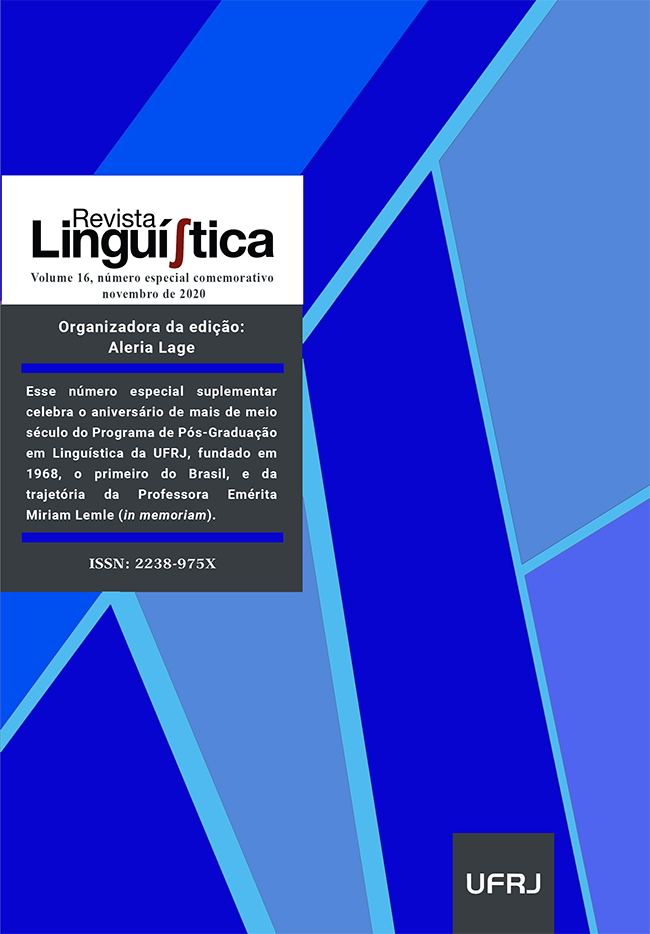Look reading course of photography by eye tracking
DOI:
https://doi.org/10.31513/linguistica.2020.v16nEsp.a43734Palavras-chave:
Percurso de leitura do olhar. Imagem. Sentidos do olhar.Resumo
Through an unprecedented experiment on “Image reading by eye tracking”, we studied the reading of syncretic multimodality as an object of study. Specifically, we investigated polysemy and polychromy as semantic phenomena of visual perception. In a situation of reading digital photography from a Brazilian advertising magazine (G Magazine), Brazilian university readers performed eye movements, building course for reading the gaze, with effects of (in) order of the image and meanings of the gaze (reading gestures). The justification for choosing such data from a specific group (heterosexual men) is based on the average answer “yes”, in relation to the question “Is there nudity in the image?” (found on the last slide of the experiment), if it presents itself differently from the “no” answers of the other five participating groups (homosexual and bisexual men, homosexual, bisexual and heterosexual women). Also by the heat map and ‘p’ value of this group, heterosexual men indicate pairwise comparisons, in relation to the areas of interest: underwear of the right model, face-wig-bust of the drag queen, face of Dicesar, sandal of the drag queen, face of right model. The analysis proposal shares theoretical knowledge of the various facets of the ‘construal’ (building of meaning, Ferrari, 2016; Ferrari et. al., 2017) and of the semantic-discursive relationship (Pêcheux, 1982, 1983, 1984; Souza, 2000, 2001, 2011 , 2013, 2018; Nascimento, 2015, 2017, 2018, 2019a, 2019b) in visual perception of reading digital photography of advertising cover, from an erotic magazine. The authors invest in the interpretation that ensures the elaboration of the answer “Yes” or “No” in the face of the question proposed in the image reading experiment.
---------------------------------------------------------------------------
PERCURSO DE LEITURA DO OLHAR DE FOTOGRAFIA POR RASTREAMENTO OCULAR
Por meio de um experimento inédito sobre “Leitura de imagem por rastreamento ocular (eye tracking)”, estudamos a leitura de multimodalidade sincrética como objeto de estudo. Especificamente, investigamos a polissemia e a policromia como fenômenos semânticos de percepção visual. Em situação de leitura de fotografia digital de revista publicitária brasileira (G Magazine), leitores universitários brasileiros realizaram movimentos oculares, construindo percursos de leitura do olhar, com efeitos de (des)ordem da imagem e sentidos do olhar (gestos de leitura). A justificativa de escolha de tais dados de grupo específico (homens heterossexuais) se baseia pela média de resposta “sim”, em relação à pergunta “Há nudez na imagem?” (que se encontrava no último slide do experimento), se apresentar diferente das respostas “não” dos demais cinco grupos participantes (homens homossexuais e bissexuais, mulheres homossexuais, bissexuais e heterossexuais). Também pelo heat map e valor de ‘p’ desse grupo homens heterossexuais indicar pairwise comparisons, em relação às áreas de interesse: cueca do modelo direito, rosto-peruca-busto da drag queen, rosto do Dicesar, sandália da drag queen, rosto do modelo direito. A proposta de análise compartilha conhecimentos teóricos das várias facetas do construal (construção do significado, Ferrari, 2016; Ferrari et. al, 2017) e da relação semântico-discursiva (Pêcheux, 1982, 1983, 1984; Souza, 2000, 2001, 2011, 2013, 2018; Nascimento, 2015, 2017, 2018, 2019a, 2019b) em percepção visual de leitura de fotografia digital de capa publicitária, de uma revista de erotismo. Os autores investem na interpretação que assegura a elaboração da resposta “Sim” ou “Não” diante da questão proposta no experimento de leitura imagética.
---
Original em inglês.
Downloads
Publicado
Edição
Seção
Licença
Autores que publicam na Revista Linguí∫tica concordam com os seguintes termos:
Os autores mantêm os direitos e cedem à revista o direito à primeira publicação, simultaneamente submetido a uma licença Creative Commons que permite o compartilhamento por terceiros com a devida menção ao autor e à primeira publicação pela Revista Linguí∫tica.
Os autores podem entrar em acordos contratuais adicionais e separados para a distribuição não exclusiva da versão publicada da obra (por exemplo, postá-la em um repositório institucional ou publicá-la em um livro), com o reconhecimento de sua publicação inicial na Revista Linguí∫tica.

A Revista Linguí∫tica é uma revista do Programa de Pós-Graduação em Linguística da UFRJ e se utiliza da Licença Creative Commons - Atribuição-NãoComercial 4.0 Internacional (CC-BY-NC)









